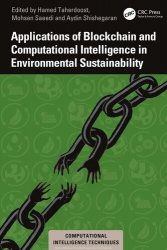 Название: Applications of Blockchain and Computational Intelligence in Environmental Sustainability
Название: Applications of Blockchain and Computational Intelligence in Environmental SustainabilityАвтор: Hamed Taherdoost, Mohsen Saeedi, Aydin Shishegaran
Издательство: CRC Press
Серия: Computational Intelligence Techniques
Год: 2025
Страниц: 178
Язык: английский
Формат: pdf (true), epub
Размер: 11.0 MB
The book explores the complex correlation between blockchain technology and sustainability, demonstrating the potential of cutting-edge computational intelligence methods to address critical environmental and societal challenges. It provides a comprehensive analysis of the most recent developments in research, innovative approaches to design, and real-world implementations, establishing a strategic plan for the incorporation of blockchain technology into environmentally friendly solutions.
Blockchain technology’s key features are decentralization, immutability, transparency, and security. This could cause a sea change in many sectors and turn the Internet we know today into an “Internet of Value.” There are far-reaching consequences for 21st-century education, corporate operations, and governance due to blockchain’s immutable distributed ledger system, which guarantees the authenticity of transactions.
Blockchain is a distributed ledger that keeps track of transactions across multiple computers in an immutable, decentralized manner. Fifth, computational logic, transparency with pseudonymity, irreversibility of records, peer-to-peer transmission, and distributed databases form its basis. A distributed ledger system, or blockchain, is a shared database that keeps track of every transaction made by any user and ensures that every user has a copy of the ledger, thanks to replication. A blockchain or hash chain is formed when each block includes a hash value of the header from the block before it, and each block contains a transaction. You can distinguish permissioned blockchains from permissionless ones by looking at how each member’s identity is defined in the network.
Blockchain technology’s decentralized design ensures that no one entity controls the data and that everyone can independently verify transactions. Everyone with access to the blockchain can see all transactions, thanks to the transparency with pseudonymity principle, and users can choose to be identified by a unique 30-plus character alphanumeric address or by providing proof of identity to others. Every block in a blockchain stores the hash value of the header from the block before it, ensuring that records cannot be changed after a transaction has been entered, according to the principle of irreversibility of records. Blockchain transactions can be effectively programmed using the computational logic principle.
Features:
Focuses on the intersection of blockchain technology, computational intelligence, and sustainability.
Covers international regulatory landscapes and ethical considerations.
Emphasizes real-world applications such as supply chain management systems and smart energy networks.
Offers concrete examples of how these technologies contribute to sustainability.
Provides insight into how new technologies are transforming health informatics.
This book is aimed at graduate students and researchers in computer engineering and environmental sustainability.
Скачать Applications of Blockchain and Computational Intelligence in Environmental Sustainability